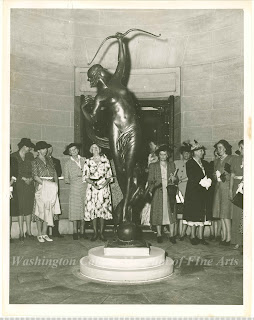Post
by: Rebecca Massie Lane
Director
"The
Christmas Pudding"
English
Traditional
Into
the basin
put
the plums,
Stir-about,
stir-about,
stir-about!
Next
the good
white
flour comes,
Stir-about,
stir-about,
stir
about!
Sugar
and peel
and
eggs and spice,
Stir-about,
stir-about,
stir-about!
Mix
them and fix them
and
cook them twice,
Stir-about,
stir-about,
stir-about!
The
artist, Frederick Stuart Church — often known in art as “the other Church” as
to separate his identity from the more well-known Hudson River School painter
— painted the holiday subject, “Cold Sauce with Christmas Pudding.”
Born
in Grand Rapids, Mich., Church was directed by his parents toward a business
career, and worked from age thirteen to 17 for the American Express Co. in
Chicago. His interest in drawing was not encouraged by formal training at this
time. When the Civil War broke out, he served for three years in the Union
artillery, and then returned to Chicago where he studied at the Chicago Art
Academy with artist Walter Shirlaw.
In
1870, he moved to New York and studied at the National Academy of Design with
Lemuel Wilmarth and at the Art Students League. Early on, he earned his living
as a commercial artist including illustrations for Harper's Weekly and later
for Frank Leslie’s Weekly, Century Magazine, and Ladies’ Home Journal.
A successful
New York illustrator at the height of the 19th century, Church’s work embodied
the Victorian taste for the whimsical, for images of animals and fashionable
young ladies, and for sentimental subjects.
Fanciful images of animals populated this work,
and his interest in bears was particularly pronounced in his winter subjects
such as the painting now on view at the Washington County Museum of Fine Arts.
Titled “Cold Sauce with Christmas Pudding,” the painting captures the qualities
of Victorian sentimentality.
Church
often visited Barnum and Bailey's premises in New York City, as well as the
Central Park Zoo, to study and make sketches of the animals held there. He also
made painting expeditions to the countryside. In one period, he lived on a farm
and taught the owner's two young daughters to draw. His patron, the banker
Grant B. Schley eventually provided Church with a specially built studio at
Schley's estate Froh Helm, located at Far Hills, N.J.
The
museum’s painting shows a fashionably
dressed young woman, complete with elaborate bonnet, in conspiracy with a
benign, jolly bear, making (and tasting) snow-icing for a Christmas pudding.
The bear holds a bowl of sugary icing sauce, licking his paw, while the lady
holds a spreading knife that also drips the sweet sauce. The pudding is the
round bomb-shaped ball on the platter. A family of rabbits helps to support the
great weight of the pudding on platter, the taller ones peeking over the edge
in anticipation of the coming feast. In the left corner, two adolescent rabbits
have snitched pieces of curled sugar cane, and two sparrows pick up the tasty
nibbles that have dropped on the snow.
Though
we get the general idea of this painting today, perhaps we can’t fully
understand the Victorian enthusiasm for the subject because Christmas pudding
has virtually disappeared from the menus of modern life.
What
is a Christmas pudding? In Victorian England and America, it is a boiled
dessert comprised of flour, sweet dried fruits, sometimes called “plum pudding” that is cooked for hours. It dates back to
medieval times, and until the 19th century, was cooked in a pudding cloth
immersed in water. The Victorians developed a new pudding cooking technique,
placing it in a basin and steaming it. It was reheated before serving, and iced
with warm brandy, which was ignited as part of the dramatic presentation of the
pudding. After the brandy fire ebbed,
the pudding would be served with a variety of possible sauces, including lemon
cream, rum butter, custard, or sweetened béchamel.
To
the Victorians, Church’s “cold sauce” enjoyed by the animals would have been
the height of hilarity. The very idea of a bear assisting in its preparation
and a lady dressed in finery icing the finished delicacy was a wonderful joke.
As
an illustrator, he was often called upon to create appropriate holiday images
for publication, including Halloween, Thanksgiving and Christmas. He
illustrated the 1878 New World publication entitled “Out of this World”,
portraying the human and animal protagonists of each of Aesop’s fables as well
as the 1881 edition of “Uncle Remus, His Songs and His Sayings: The Folk-Lore
of the Old Plantation,” by Joel Chandler Harris, published in New York by D.
Appleton and Co.. He was a member of the National Academy of Design.
In the same year that he painted “Cold Sauce,”
Church also created an etching for the Harper’s Weekly Children’s edition,
referencing Christmas pudding. This
illustration was accompanied by John Kendrick Bangs’s poem, “The Christmas Pudding.”
A Fairy small told me,
Over the frosty snow and rime
Is a rich plum-pudding tree;
A pudding-tree so large and
fine,
That never a day doth pass
That dozens of puddings and
pies divine
Don't fall on the soft green
grass.
"Cold Sauce with Christmas Pudding" is on view now in the WCMFA's lobby. It was through the inventory process that the inventory team was able to easily select a work of art fitting for the holiday season.






























copy.jpg)